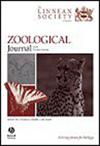Don’t go with the flow: cranial adaptations of stream tadpoles in the Afrobatrachian family Arthroleptidae
IF 3
2区 生物学
Q1 ZOOLOGY
引用次数: 0
Abstract
Arthroleptidae are an ecologically diverse group of sub-Saharan frogs. Arthroleptid tadpoles predominately occur in slow flowing to torrent waters. Their musculoskeletal system and the relationship between tadpole morphology and lifestyle are poorly understood. Here, we investigated the cranial morphology of four arthroleptid tadpoles occurring in different microhabitats: Leptopelis parkeri, Astylosternus occidentalis, Trichobatrachus robustus, and Nyctibates corrugatus. The crania of the tadpoles of A. occidentalis, N. corrugatus, and T. robustus are highly modified relative to L. parkeri, with wide and partly or completely fused cornua trabeculae, a fused cartilago labialis superior, as well as several modifications of the palatoquadrate, such as a broad commissura quadratocranialis and a processus ventralis which expands the surface for the origin of the large m. orbitohyoideus. The processus hyoquadratis is an evolutionary novelty, forming a functional unit together with the ceratohyale in the cranium of N. corrugatus. Finally, we compared the cranial morphology of these arthroleptids to other lotic and non-lotic species. Although the processus ventralis is not a generalized feature of the cranium in lotic species, it is not present in lentic species.不随波逐流:非蝠鲼科蝌蚪的头颅适应性
节肢蛙科(Arthroleptidae)是撒哈拉以南地区的一个生态多样性蛙类。节肢蛙科蝌蚪主要生活在缓流至激流水域。人们对它们的肌肉骨骼系统以及蝌蚪形态与生活方式之间的关系知之甚少。在这里,我们研究了在不同微生境中生活的四种节肢动物蝌蚪的头盖骨形态:Leptopelis parkeri、Astylosternus occidentalis、Trichobatrachus robustus和Nyctibates corrugatus。相对于 L. parkeri,A. occidentalis、N. corrugatus 和 T. robustus 的蝌蚪头盖骨高度变形,有宽阔的、部分或完全融合的颚骨小梁,融合的唇上软骨,以及腭胛骨的一些变形,如宽阔的四栉齿状突和腹侧突,腹侧突扩大了大型眶下突的起源表面。喙突是一种新的进化特征,它与冠突一起构成了冠突蜥头颅骨的一个功能单元。最后,我们将这些节肢动物的颅骨形态与其他地栖和非地栖物种进行了比较。虽然腹凸不是荷叶物种颅骨的普遍特征,但在内陆物种中却不存在。
本文章由计算机程序翻译,如有差异,请以英文原文为准。
求助全文
约1分钟内获得全文
求助全文
来源期刊
CiteScore
6.50
自引率
10.70%
发文量
116
审稿时长
6-12 weeks
期刊介绍:
The Zoological Journal of the Linnean Society publishes papers on systematic and evolutionary zoology and comparative, functional and other studies where relevant to these areas. Studies of extinct as well as living animals are included. Reviews are also published; these may be invited by the Editorial Board, but uninvited reviews may also be considered. The Zoological Journal also has a wide circulation amongst zoologists and although narrowly specialized papers are not excluded, potential authors should bear that readership in mind.

 求助内容:
求助内容: 应助结果提醒方式:
应助结果提醒方式:


